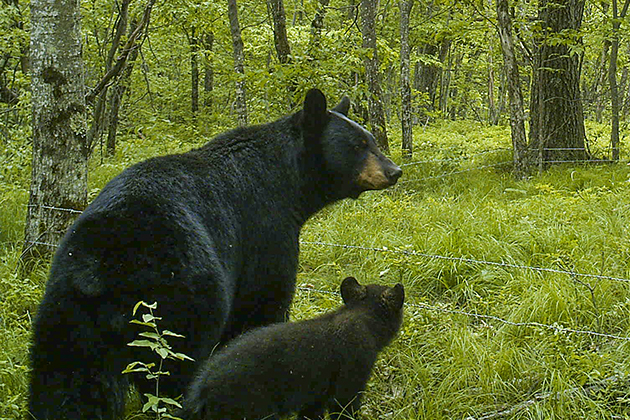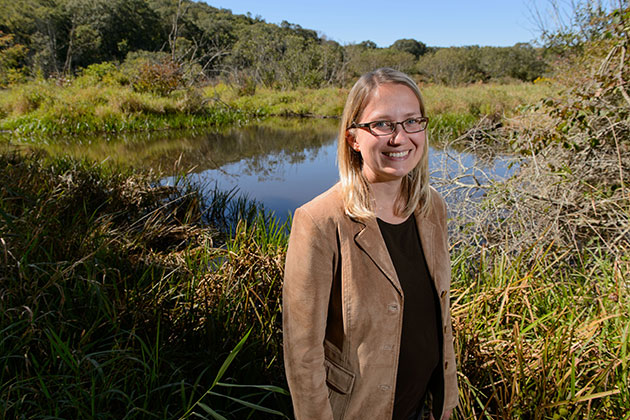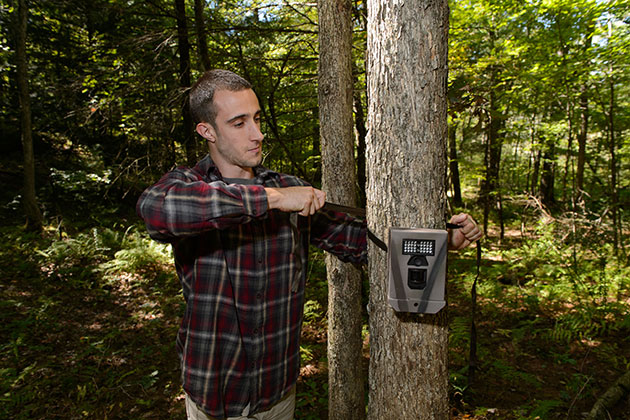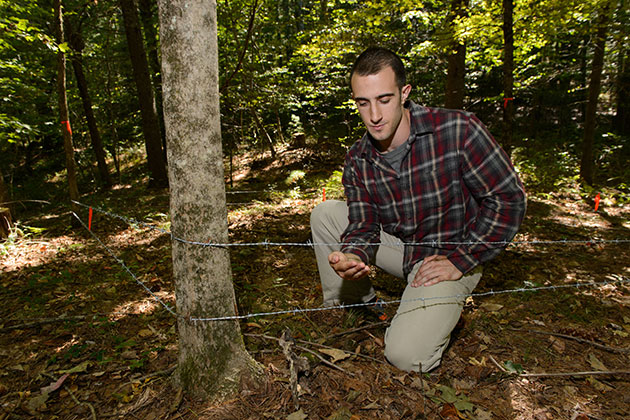
Tracy Rittenhouse, assistant professor in the Department of Natural Resources and the Environment, knows a thing or two about black bears (Ursus americanus americanus). She also knows about species as diverse as Eastern and New England cottontails, spotted salamanders, woodcock, and white-tailed deer, among others.
And although Rittenhouse is engaged in a variety of studies involving a number of these species, she has garnered attention recently due to her work with the Connecticut Department of Energy and Environmental Protection (DEEP), studying the state’s seemingly burgeoning black bear population.

“I’m working with DEEP to get a better idea of just how many black bears we have in the state,” she says. “We’re trying to determine if the population is growing, or if the bears are simply expanding their range into the suburban landscape. In order to do this, we’re using a non-invasive sampling technique that involves something called a hair corral.”
A hair corral is a string of barbed wire stretched around a group of trees. A scent lure (usually a liquid smelling of dried fish or black licorice) is placed in the middle of the site, and that attracts curious bears. When they climb over or under the wire, they leave hair samples behind, snagged on the barbs.
Rittenhouse and her students have set up about 150 hair corrals, broken into three grids, west of the Connecticut River. These grids span gradients of human density, and some of them are in quite populated areas. In a few cases, they go right into people’s back yards.
Rittenhouse has a Ph.D. student and some undergraduates who spent their summer driving around collecting the hairs, in order to do DNA analysis on the samples. That way, they can determine how many individuals visit each corral and how they may be related to each other, without disturbing the bears at all. This past summer was the second of three summers of data collection.
“It may be stating the obvious,” Rittenhouse says, “but hair corrals are definitely easier on the bears – and on us – than it would be if we had to trap and tranquilize them in order to fit them with ear tags and then re-trap them, as is required for typical mark-recapture studies. This is hands off, and I think both [the bears and the researchers] prefer it that way.”


Successional forests create habitat
While the region’s earliest settlers found a land virtually covered by trees, by 1825 when agriculture was burgeoning, only about 25 percent of Connecticut was forested. Now, approximately 60 percent of the state is forested, with the remaining land devoted to farmland, housing, commercial and industrial areas, wetlands, and recreational areas.
The regrowth of trees in areas that were once cleared is termed forest succession, and forests of differing ages provide habitat for a wide variety of wildlife species.
The fact that there are black bears roaming around suburban back yards is not necessarily surprising, Rittenhouse says, given their adaptable nature. The white-tailed deer population is flourishing in the state for similar reasons. On the one hand, these animals thrive as they feed on acorns from oak trees that are now reaching maturity, but they are also more than willing to sample the content of bird feeders or ornamental flowers and shrubs in the cultivated suburban yards that now punctuate the forests of Connecticut.
Keeping an eye on indicator species gives us a report card on how we are doing, and gives us an idea of what we have to look forward to in the future.
Rittenhouse’s research interests include theories of habitat selection, migration and dispersal, and biodiversity and ecosystem function. She hopes to explore the factors that contribute to the long-term persistence of wildlife populations, given anticipated levels of global change.
Under the umbrella of global change, she includes such things as climate change, land development, the spread of invasive species, and the prevalence of various wildlife diseases.
As she views the landscape, Rittenhouse sees connections among species that may not be readily apparent to others. Lately, she has been intrigued by the role beaver wetlands play in creating habitat for species that live in mature forests, as well as those that live in younger, early successional forests.
When beavers make dams, they create wetlands that flood an area and kill some of the trees. “These open, canopied wetlands are great for tadpoles and other amphibians,” Rittenhouse says, “because they tend to do well when there is some sunlight reaching the water. Since the water goes right up against hardwood forests, tadpoles can easily transition into frogs that live in mature forest habitats.”
Eventually, the beavers move on, their dams collapse, and water flows out. What is left is analogous to a [forest] clear cut. As the young forest regrows during the next 10 to 15 years, it becomes early successional habitat for woodcock and rabbit.
The big picture
The presence, absence, or relative well-being of so-called indicator species – wildlife living in a given environment – is indicative of the overall health of an ecosystem, Rittenhouse explains. The diversity of species holds particular interest for her.
“What is important to me is that we maintain our wildlife populations, despite changes in their habitats. In order to do that, we need to know about reproductive and mortality rates and about which [successional forest] age class is most important to a population as a whole. Keeping an eye on indicator species gives us a report card on how we are doing, and gives us an idea of what we have to look forward to in the future.”



